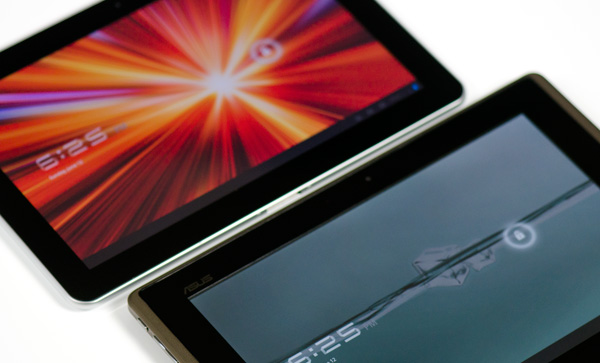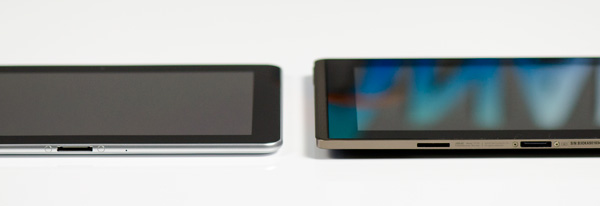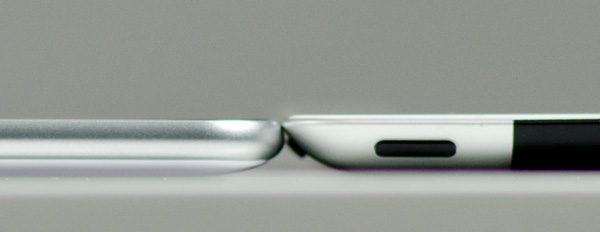Samsung Galaxy Tab 10.1 Review: The Sleekest Honeycomb Tablet
by Anand Lal Shimpi on June 13, 2011 5:07 AM EST- Posted in
- Tablets
- Samsung
- Tegra 2
- Galaxy tab 10.1
- Android 3.1
- Mobile
- NVIDIA
I remember standing in the audience of Samsung's CTIA press conference as it announced, for the first time ever, pricing and availability of its unreleased Galaxy Tab 10.1 and 8.9 before shipping. The smartphone (and early tablet) industries have gone this long without having to really compete based on price, mostly because in North America the carriers subsidize much of the cost. If every device costs $199 under contract, why get carried away with details like how much it actually costs?
The Galaxy Tab however was playing in a different space. While Apple ultimately caved to the pressures of carrier subsidies with the iPhone, the iPad remains completely unsubsidized and its followers buy it by the millions. The magical price point is $499 and it was at Samsung's CTIA press conference that it announced it would be matching Apple's $499 price point, and even dropping slightly below it for the 8.9-inch version.
At the time it seemed like a bold move, enough to give Honeycomb the fighting chance it needed. The Galaxy Tab would be thinner and lighter than the iPad 2 but competitively priced as well. This wouldn't be another Xoom.

Samsung Galaxy Tab 10.1 (top) vs. ASUS Eee Pad Transformer (bottom)
Then ASUS showed up. At $399, the Eee Pad Transformer not only offered a different usage model to the iPad and Galaxy Tab, it brought a lower price tag as well. Availability has been slim thanks to component shortages, but with the Eee Pad selling for $399 the Galaxy Tab at $499 all of the sudden seems overpriced.
| 2011 Tablet Comparison | ||||||
| Apple iPad 2 | ASUS Eee Pad Transformer | Motorola Xoom WiFi | Samsung Galaxy Tab 10.1 | |||
| SoC | Apple A5 (Dual ARM Cortex A9 @ 1GHz) | NVIDIA Tegra 2 (Dual ARM Cortex A9 @ 1GHz) | NVIDIA Tegra 2 (Dual ARM Cortex A9 @ 1GHz) | NVIDIA Tegra 2 (Dual ARM Cortex A9 @ 1GHz) | ||
| GPU | PowerVR SGX 543MP2 | NVIDIA GeForce | NVIDIA GeForce | NVIDIA GeForce | ||
| RAM | 512MB | 1GB | 1GB | 1GB | ||
| Display | 1024 x 768 IPS | 1280 x 800 IPS | 1280 x 800 | 1280 x 800 PLS | ||
| NAND | 16GB | 16GB | 32GB | 16GB | ||
| Dimensions | 241.2mm x 185.7mm x 8.8mm | 271mm x 175mm x 12.95mm | 249.1mm x 167.8mm x 12.9mm | 256.6 x 172.9 x 8.6mm | ||
| Weight | 601g | 695g | 730g | 565g | ||
| Price | $499 | $399 | $599 | $499 | ||
Based on specs alone you'd be right. Samsung's Galaxy Tab 10.1 has the same NVIDIA Tegra 2 tablet SoC inside,
1GB of LPDDR2 and 16GB of NAND on-board. You get a 10.1-inch 1280 x 800 PLS display and 802.11n WiFi support. It's worth pointing out that we're now well into the month of June and NVIDIA continues to be the only SoC vendor shipping in Honeycomb tablets. Samsung originally had plans to ship its own Exynos SoC in the Galaxy Tab but Tegra 2 remains the port of choice for all Honeycomb vendors at this point. Whether or not NVIDIA can win twice in a row with Ice Cream Sandwich later this year remains to be seen.

Samsung Galaxy Tab 10.1 (left) vs. ASUS Eee Pad Transformer (Right)
Where Samsung gives you something more for your money is in build quality and form factor. While Eee Pad Transformer feels surprisingly good for a cost reduced tablet, it doesn't feel nearly as slim or portable as the Galaxy Tab 10.1. It's no wonder Samsung went back to the drawing board on this one, the result is something that in many ways feels better than the iPad 2.
Apple still gets the nod in terms of quality of materials. The aluminum back of the iPad 2 is unbeatable. The Galaxy Tab 10.1 however feels lighter, a bit more rugged (I'm less concerned about scratching plastic than I am marring aluminum) and a little more comfortable to hold as a result. Against the Eee Pad there's no competition. I can live with the Eee Pad, but I much prefer the feel of the Galaxy Tab 10.1. The new Tab just feels like a device from this year - a compliment that, until now, I had only given to Apple.
The Galaxy Tab 10.1 measures just 8.6mm thick, 0.2mm thinner than the iPad 2. To be honest you really can't tell the difference, both devices feel thin. Ever after holding them back to back it's near impossible to tell that Samsung has built a thinner device. The most tangible difference in feel is the weight, not just in overall mass but in terms of weight distribution. The Galaxy Tab seems to carry the weight a bit better than the iPad, a bit more evenly.

Samsung Galaxy Tab 10.1 (left) vs. Apple iPad 2 (right)
Now is as good a time as any to point out that although Samsung calls this the Galaxy Tab 10.1, it's really the new Galaxy Tab 10.1. Originally Samsung announced a much thicker version at Mobile World Congress, a month prior to the CTIA announcement. With the much thinner iPad 2 hitting the market after the original 10.1 announcement, Samsung scrapped plans for the original and unveiled the thinner 8.6mm version as the new Galaxy Tab. The original Galaxy Tab 10.1 is now known as the Galaxy Tab 10.1v.












108 Comments
View All Comments
Jamestownsend - Tuesday, June 14, 2011 - link
Actually, the iPad 1 beats it in a lot of areas. its not nearly as buggy or sluggish. Plus the iPad 1 is actually useful. It can do more than just browse the internet and play ad-sponsored angry birds...vision33r - Friday, June 17, 2011 - link
You're in idiot. I mentioned the Tegra 2 with a dual core CPU is not even faster than many single core CPU by much.The iPad 2's A5 spanks the Tegra 2 so hard it's not even a contest.
medi01 - Monday, June 13, 2011 - link
7 inch version sales are already above 1 million.Wizzdo - Tuesday, June 14, 2011 - link
iPad2 still beats it with a great OS (which gets very significant perks with the soon-to-be-released iOS5) and significantly faster graphics.Samsung gets the nod slightly on the hardware side but a pitty they had to sacrifice a memory card slot to do it which would be the only real advantage (other than a slightly better display) over an iPad2 for me.
Plus, who knows if it'll ever get a descent OS upgrade and it will be obsolete in 4 months due to Kal-El.
I think I'll stick with the iPad2. A hot body without a good brain is pretty much only good for one thing ...uhh... looking at.
*I find it troubling that Samsung would bite off the hand that feeds them and likely abuse Apple's trade secrets (Apple is suing them) to produce this. It takes quite a few points away from any rewards I would give them for their hardware improvements and makes me question the integrity of the company in general.
abrar - Monday, June 13, 2011 - link
so why i should go from my currently Tab P1000 (andr 2.1) to the new Tab 10.1??just to upgrade to honey comb ?
at least samsung should have implemented HDMI....
ph00ny - Monday, June 13, 2011 - link
I could have sworn i saw the damn thing plugged into the TV using the HDMI cable into the MHL adapter. Also you can always use wireless DNLAJohnmcl7 - Monday, June 13, 2011 - link
Not planning on giving up my P1000, the main disappointment is the lack of onboard ports - no hdmi, no SD card slot and no USB port (for connecting storage devices). The fact the 10in model is double the size but has even less (no microSD slot) seems a bit of a joke to me. Having used an Ipad 2 I can't say I understand this need to be small particularly given the large sacrifices needed to achieve that.John
g1011999 - Monday, June 13, 2011 - link
I think all honeycomb devices on the market have 1GB RAM.g1011999 - Monday, June 13, 2011 - link
At least for my Asus Transformer.Anand Lal Shimpi - Monday, June 13, 2011 - link
You're right, it has been fixed :)Take care,
Anand